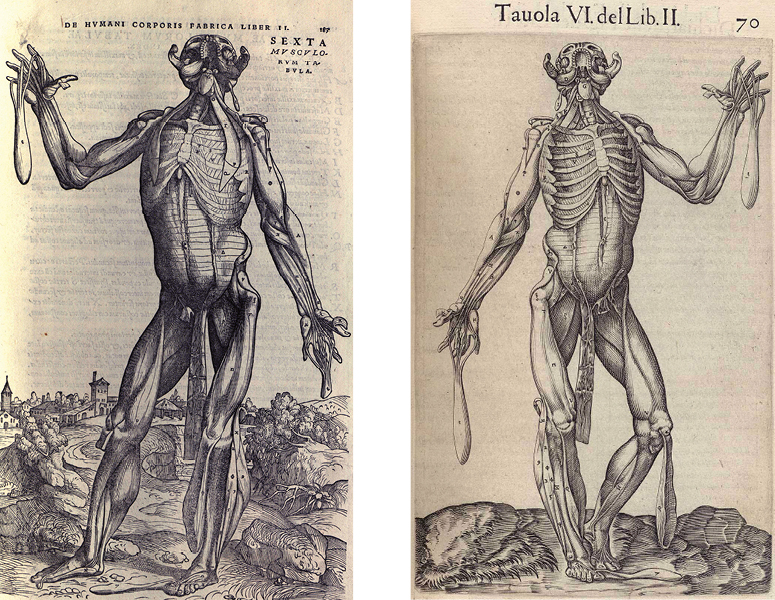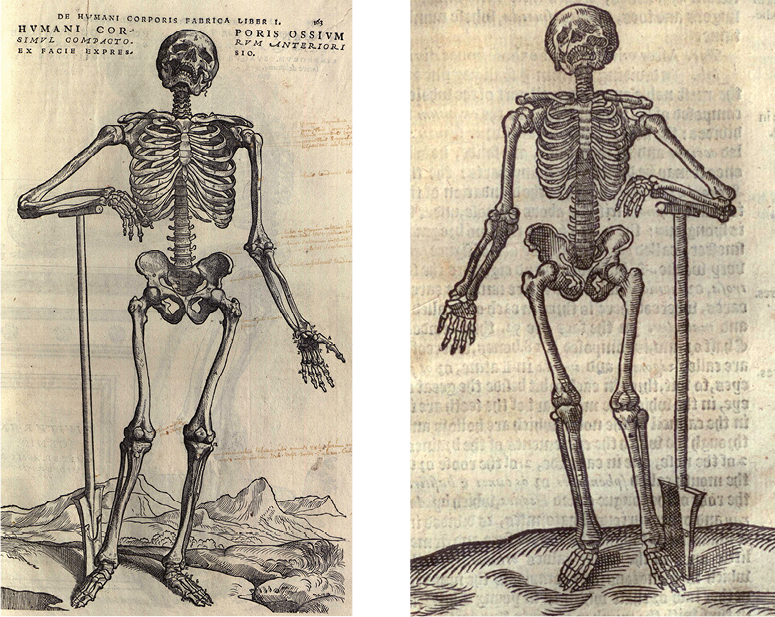Some of the most famous images in the history of medicine can be found in Andreas Vesalius’s “De humani corporis fabrica,” published in 1543 by Johannes Oporinus. Medical illustration prior to Vesalius tended to be rather crude and schematic, but the woodcuts that appeared in the Fabrica managed to capture an extraordinary amount of detail with a high degree of artistic beauty. No one had seen anything like quite like them, and they marked a huge leap forward in the illustration of human anatomy.
These remarkable illustrations soon took on a life of their own. Many other medical writers appropriated the images in the Fabrica and inserted them into their own texts. One of the most famous examples of this is in the Spanish anatomist Juan Valverde de Amusco’s “Anatomia del corpo humano” (of which Becker Library holds editions dating from 1560, 1586 and 1608). Valverde’s atlas was first printed in Rome in 1556, thirteen years after the publication of the Fabrica, and contained forty-two copperplate engravings. Of these, only four were original to Valverde. The rest were almost direct copies of Vesalius’ earlier images. If you look at these stylized depictions of the muscles, you can see that Valverde (right image) simplified the background and made a minor adjustment to the position of the legs, but it is clearly modeled on Vesalius’s work (left image).

How exactly could this sort of blatant plagiarism have taken place? In today’s world, content creators are protected by copyright law and can take legal action against someone who appropriates their work. In the early modern world, however, authors had little recourse against pirates. Strict copyright law was still many years in the future, and in order to protect his work, Vesalius needed to rely on something called a privilege.
Privileges were granted for a set time period by the legal authorities of a specific region – a city, state or country – in order to protect the rights of the person to whom the privilege was granted. This could be an exemption from taxes, a monopoly on the import of certain goods, or exclusive printing rights to a certain text. If you look closely at the title page of the Fabrica, you can see a small cartouche at the very bottom that contains a few lines of text beginning with “CUM CEASARAE.” This text lists the various privileges that accompanied the Fabrica’s printing: one from the Holy Roman Emperor (Ceasarae), one from the King of France (Galliarum Regis), and one from the Venetian Senate (Senatus Veneti). These privileges protected the Fabrica from plagiarism in areas controlled by these rulers.

The problem with privileges was that they were only applicable in the regions where they were issued. While Vesalius was protected in the Empire, France and Venice, he had no defense against plagiarized editions that were published in other areas. Because Valverde’s Anatomia was printed in Rome, a city where Vesalius did not have a privilege, there was nothing he could do about it (no matter how much he would have liked to).
Plagiarisms of Vesalius’s illustrations appeared throughout the early modern period and their quality varied wildly. While Valverde’s copies were executed with a reasonable degree of skill, others were much less aesthetically appealing. For example, Vesalius’ famous image of a skeleton apparently digging its own grave later appeared in Peter Lowe’s “A discourse of the whole art of chyrurgerie.” When the two images are placed side by side – the image below on the right comes from Lowe’s third edition (London: Thomas Purfoot, 1634) with Vesalius's on the left – it is immediately apparent that Lowe’s image is of very poor quality.

While Vesalius himself wanted to protect his masterwork and went to the trouble of securing privileges, the nebulous nature of early modern copyright meant there was little he could do to prevent plagiarism. On the other hand, the diffusion of his woodcuts throughout the landscape of medical publishing proves just how great his impact on medical illustration was. Imitation is truly the sincerest form of flattery.
